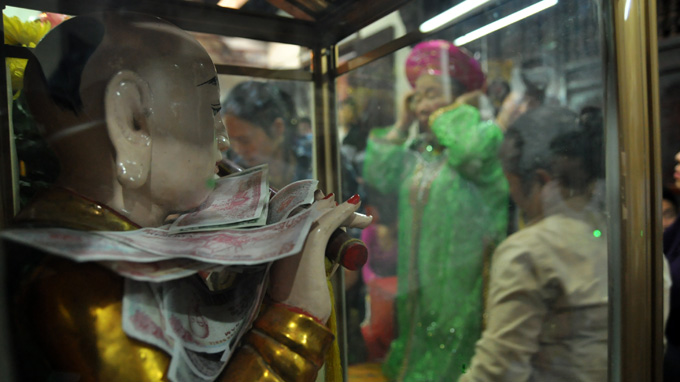The latest scandal involving the head of the Hoang Muoi temple in central Nghe An province, who regularly has another company count donated money, has deepened suspicion regarding how much donated money the management of local pagodas and temples collect, and how they use it.
“Religious donation money is indeed beyond our comprehension,” exclaimed a local culture researcher.
According to him, the management of donations varies considerably from one pagoda or temple to another, with the money being even more inaccessible to outsiders at big, famous religious institutions.
‘Buying’ good luck
Apart from the VND500 (US$0.02), 1,000, 2,000 and 5,000 denominations notes scattered on altars, over recent years visitors have formed the habit of thrusting such money anywhere accessible, including tree bases, the Buddha’s and deities’ hands, costumes and even ears, believing that the more money they donate, the more good luck they will get.
At the Cua Ong temple in northern Quang Ninh province, to cope with visitors throwing money indiscriminately on its precincts and statues, its managers have put in place scores of plastic baskets.
During the Huong pagoda festival in Hanoi every Lunar New Year, the pagodas within the area send their staff to collect small notes and put them into sacks every few hours.
Several tourist spots and religious institutions, such as the Giai Oan spring in northern Quang Ninh province and the Ngoc well in northern Phu Tho province’s Hung temple, usually suffer blockages in their facilities due to the inundation of small notes. In recent years, the Hung temple’s management has installed nets to stop small notes from being thrown into the well.
Since the Tran temple in northern Nam Dinh province has had its palanquin processions restored, hundreds of guest visitors, most of who are local officials and their relatives, often jostle their way to the front and throw small notes for good luck. They are even assisted by the security guards, who roll the notes into balls and target the palanquins and the people carrying them.
Visitors also cover the roof of the Thai Hoc edifice in the Van Mieu – Quoc Tu Giam (The Temple of Letters, the country’s first university) with small notes.
Shady management
Considering the fact that some temples receive hundreds of thousands of visitors a year, most of whom scatter stacks of small notes in return for good luck and blessings, and the density of the money boxes kept in pagodas and temples to collect donations from visitors, the sums collected by day’s end are whopping.
Apart from the small notes, which visitors often scatter on small discs on altars to pay for the lamps’ kerosene and the institutions’ overhead management and maintenance fees, donation money also consists of the money kept in locked boxes or the generous sums which visitors donate directly to the head monks/nuns or heads of the management. Many philanthropists and donors wish to remain anonymous to make their contributions more religiously meaningful.
According to Dao Minh Tu, deputy governor of the State Bank, during the Lunar New Year alone, a small pagoda in the vicinity of the Huong pagoda collected a whopping VND6 billion (US$288,462) in small-denomination notes. It took the local bank which the pagoda head hired to count the huge sum a few days to finish the task.
At many religious institutions the management of enormous sums of donated money, however, remains shady and inaccessible to outsiders.
Apart from handing in a certain sum to the Nam Dinh People’s Committee every year, the Tran temple’s management board uses and manipulates a big part of the donated money it receives on its own.
The management board of the Ba Chua Kho temple in northern Bac Ninh province is widely known for its exclusive, discreet use of donated money. The only thing outsiders know is that its yard is full of steles inscribed with the names and backgrounds of generous donators.
To find out more about the money received by a famed ancient communal house in Hanoi, several researchers had to total up an approximate sum from separate services offered at the house, multiplied by the note denominations.
Though the institutions’ management regularly submits their reports of donated money to the local authorities, the numbers in the reports are a far cry from the actual ones.
Unable to manage their donatedd money, many religious institutions now turn to hiring professional companies to do the job, which turns the sacred religious meccas into lucrative businesses.


















































